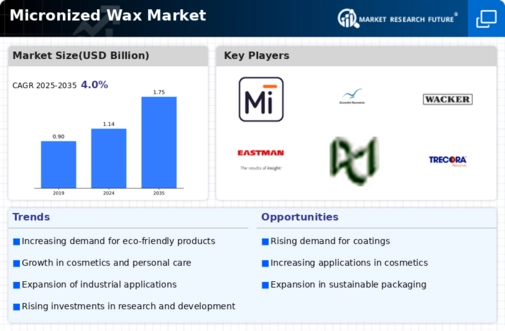Market Growth Projections
The Global Micronized Wax Market Industry is poised for substantial growth, with projections indicating a market size of 1.14 USD Billion in 2024 and an anticipated increase to 1.75 USD Billion by 2035. This growth trajectory suggests a compound annual growth rate of 3.96% from 2025 to 2035. Such projections reflect the increasing adoption of micronized waxes across various industries, including coatings, personal care, and plastics. The diverse applications and benefits of micronized waxes contribute to their rising popularity, positioning the market for continued expansion in the coming years.
Growth in Personal Care Products
The Global Micronized Wax Market Industry benefits from the increasing incorporation of micronized waxes in personal care formulations. These waxes are utilized in a variety of products, including lipsticks, creams, and lotions, where they contribute to texture, stability, and moisture retention. The rising consumer preference for high-quality personal care items is likely to propel market growth. As consumers become more conscious of product ingredients, manufacturers are focusing on incorporating natural and sustainable micronized waxes. This trend aligns with the projected growth of the market, which is expected to reach 1.75 USD Billion by 2035, indicating a robust expansion in this sector.
Increasing Applications in Plastics
The Global Micronized Wax Market Industry is experiencing growth due to the expanding applications of micronized waxes in the plastics sector. These waxes are utilized as processing aids and surface modifiers, enhancing the performance and aesthetics of plastic products. As the demand for high-quality plastics rises, particularly in packaging and consumer goods, the need for micronized waxes is expected to increase. This trend is supported by the projected market growth, which is anticipated to reach 1.14 USD Billion in 2024. The versatility of micronized waxes in improving the properties of plastics positions them as essential components in this evolving market.
Rising Demand in Coatings and Paints
The Global Micronized Wax Market Industry experiences a notable surge in demand from the coatings and paints sector. Micronized waxes serve as effective additives that enhance the durability and finish of coatings, providing improved scratch resistance and gloss. As the construction and automotive industries expand, the need for high-performance coatings increases. In 2024, the market is projected to reach 1.14 USD Billion, reflecting a growing trend towards quality and performance in surface treatments. This demand is expected to drive innovation in formulations, further solidifying the role of micronized waxes in enhancing product performance.
Sustainability Trends in Manufacturing
Sustainability trends are shaping the Global Micronized Wax Market Industry as manufacturers increasingly seek eco-friendly alternatives. The demand for sustainable products is prompting companies to explore bio-based and renewable sources for micronized waxes. This shift not only aligns with consumer preferences but also complies with regulatory pressures for environmentally friendly manufacturing practices. As sustainability becomes a core focus, the market is likely to expand, with projections indicating a growth trajectory that could reach 1.75 USD Billion by 2035. This emphasis on sustainability may drive innovation and collaboration within the industry, fostering a more responsible approach to production.
Advancements in Manufacturing Technologies
Technological advancements in the production of micronized waxes are significantly influencing the Global Micronized Wax Market Industry. Innovations in milling and processing techniques allow for the production of finer and more consistent wax particles, enhancing their performance in various applications. These advancements not only improve product quality but also reduce production costs, making micronized waxes more accessible to manufacturers. As a result, the market is likely to witness a compound annual growth rate of 3.96% from 2025 to 2035. This growth is indicative of the industry's adaptability and commitment to meeting evolving consumer demands through improved manufacturing processes.














